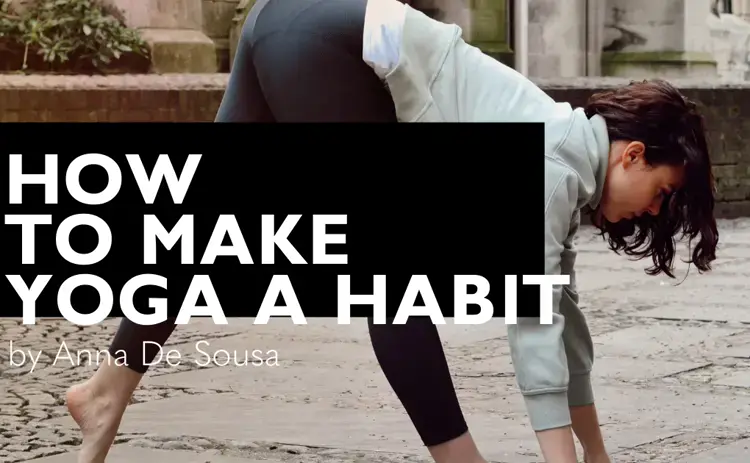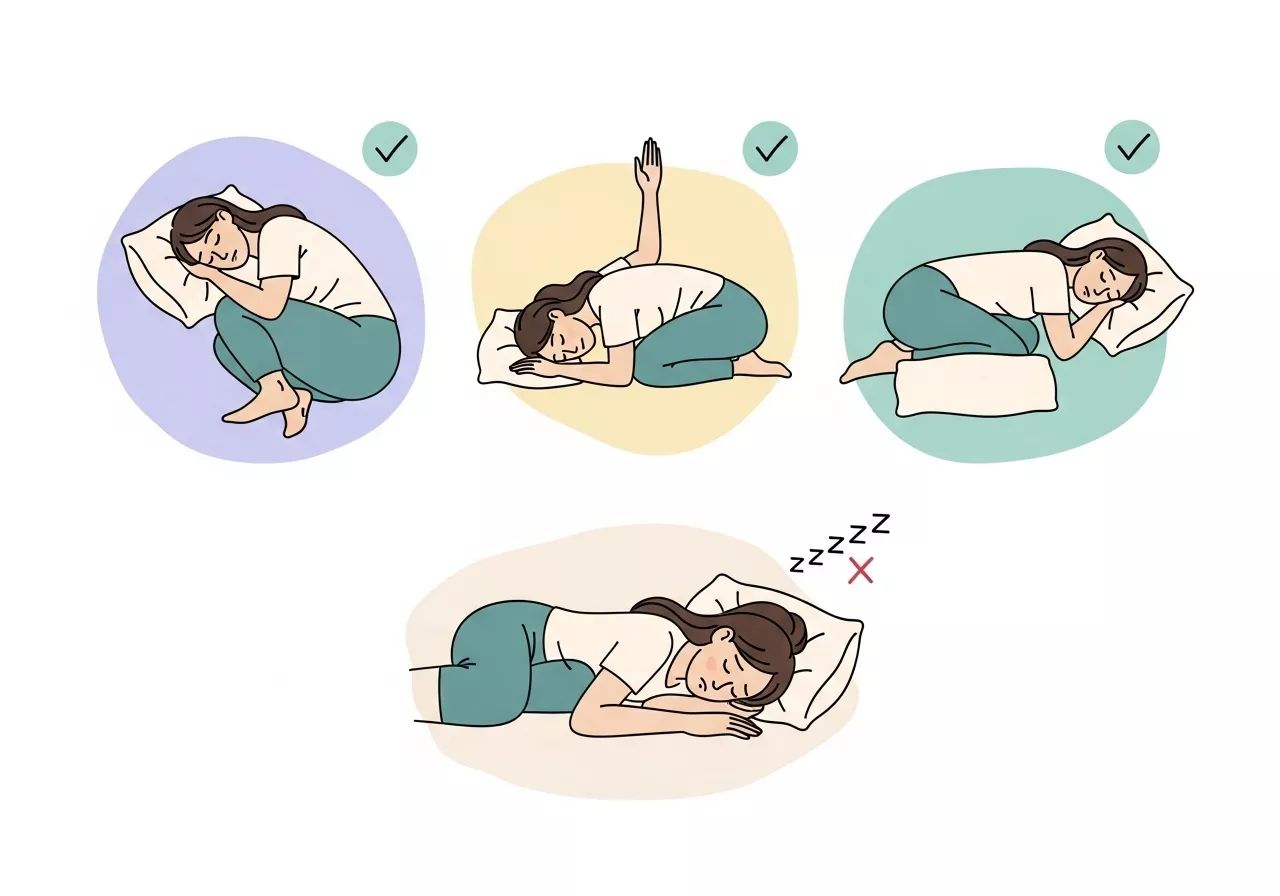Creating a consistent yoga practice can transform your physical, mental, and emotional well-being. However, building a habit that sticks takes time and intentional effort.

Here’s a detailed, step-by-step guide to help you integrate yoga seamlessly into your daily routine and make it a lifelong practice.
1. Pair Yoga with an Existing Habit

Why it works: Habit stacking is a proven method to build new routines by linking them to something you already do.
- Identify a daily habit such as brushing your teeth, making coffee, or your morning shower.
- After completing this routine, immediately start your yoga practice. For instance, roll out your mat right after brushing your teeth each morning.
- This creates a mental cue that triggers your yoga practice, making it feel like an extension of your day.
2. Set Specific, Realistic Goals

Why it works: Having clear goals keeps you motivated and provides a sense of accomplishment.
- Start small: Commit to 10 minutes of yoga daily, and gradually increase as your body adapts.
- Define your “why.” Are you aiming for better flexibility, stress relief, or improved strength? Understanding your motivation can keep you inspired on tough days.
- Break larger goals into smaller milestones. For example, if you aim to master a challenging pose like the crow, dedicate a few minutes daily to build strength and balance.
3. Create a Dedicated Yoga Space

Why it works: A consistent environment makes it easier to establish a routine.
- Choose a quiet area with minimal distractions, such as a corner of your bedroom or living room.
- Set the mood: Add a mat, blocks, and perhaps a candle or plant to make it inviting.
- Keep the space ready to use so you can start practicing without needing to set up every time.
4. Plan Your Practice in Advance

Why it works: Decision fatigue can hinder your motivation. Planning removes this barrier.
- Decide the time of day and duration for your yoga session. Whether it’s a 15-minute morning stretch or a 45-minute evening flow, consistency is key.
- Choose your style and sequence ahead of time. For example, on busy days, opt for a quick Sun Salutation series. On weekends, try a restorative or longer session.
- Use apps, YouTube, or classes for guided practice if you’re unsure what to do.
5. Prepare the Night Before

Why it works: Preparation reduces excuses and builds momentum.
- Lay out your yoga outfit, water bottle, and any props the night before.
- Set your alarm early if you plan to practice in the morning, and put it across the room to encourage getting up.
- Create a playlist or cue up a yoga video so it’s ready to go.
6. Prioritize Consistency Over Perfection

Why it works: Regular practice yields more benefits than occasional, lengthy sessions.
- Even five minutes of gentle stretching is better than skipping a day entirely.
- On days when you’re sore or tired, do a restorative session or simply sit on the mat and breathe. Consistency builds discipline and reinforces the habit.
7. Track Your Progress

Why it works: Monitoring your practice helps you stay accountable and see improvements.
- Use a journal to record your sessions: duration, poses practiced, and how you felt afterward.
- Set a habit tracker to check off each day you practice yoga.
- Reflect monthly on how far you’ve come. Have you gained flexibility? Are you feeling less stressed?
8. Create a Rewards System

Why it works: Positive reinforcement encourages continued effort.
- Reward yourself for milestones, like completing 30 days of consistent practice.
- Treats can range from a new yoga prop (mat, blocks, or clothing) to a relaxing spa day.
- Celebrate your progress to stay motivated and make the habit enjoyable.
9. Focus on the Benefits

Why it works: Constant reminders of the benefits keep you inspired.
- Make a list of the physical, mental, and emotional rewards yoga brings you. For example:
- Improved flexibility and posture.
- Reduced stress and anxiety.
- Better sleep quality.
- Place this list somewhere visible, like your practice space or journal, as a daily motivator.
10. Join a Community

Why it works: Accountability and support from others can help you stay committed.
- Attend a local yoga class or join an online yoga group.
- Share your progress and challenges with like-minded individuals who can offer encouragement.
- Partner with a friend or family member to practice together, whether in person or virtually.
11. Be Kind to Yourself
Why it works: Habits take time, and self-compassion helps you persevere.
- Understand that it’s okay to miss a day or struggle with motivation. What matters is getting back on track.
- Celebrate small victories, like showing up on the mat, even if it’s just for a short session.
- Embrace the journey, not just the destination.
Building a Yoga Habit: Final Thoughts
Consistency, patience, and a clear understanding of your goals are the keys to making yoga a permanent part of your lifestyle.
By implementing these strategies, you’ll not only enjoy the physical benefits but also nurture a more balanced, peaceful state of mind.
Over time, yoga will become an essential part of your daily routine—a habit you can’t imagine living without.
Is It Normal to Struggle with Yoga?
Yes, it is absolutely normal to struggle with yoga, especially when you’re just starting or trying to deepen your practice.
Yoga is as much a mental and emotional journey as it is a physical one, and challenges are a natural part of this growth.
Struggling is not a sign of failure but rather an opportunity to learn, adapt, and strengthen both your body and mind.

Here’s a deeper look at why struggling is normal and how to navigate these challenges:
1. Physical Challenges
- Flexibility and Strength: Many beginners face difficulties with flexibility, strength, or balance. If you’ve been inactive or are new to yoga, your body needs time to adapt. Even advanced practitioners encounter poses that challenge their limits.
- Muscle Soreness: It’s common to experience soreness as your body gets used to new movements. Certain poses target muscles you might not use often, which can lead to temporary discomfort.
- Overcoming Plateaus: Even seasoned yogis hit plateaus where progress seems slow or non-existent. This is a natural part of any physical practice.
How to Address It:
- Start with beginner-friendly poses and gradually build up to more advanced ones.
- Incorporate strength-building exercises and stretches into your routine.
- Practice patience and consistency; improvement happens over time.
2. Mental Challenges
- Focus and Mindfulness: Yoga emphasizes being present, which can be difficult in a world filled with distractions. Many struggle with calming the mind or staying focused during practice.
- Comparing Yourself to Others: It’s natural to look at others in a yoga class or online and feel inadequate. This comparison can lead to frustration and self-doubt.
- Setting Unrealistic Expectations: Expecting rapid progress or perfection can lead to discouragement when things don’t go as planned.
How to Address It:
- Use yoga as a tool to practice mindfulness. Focus on your breath and movements rather than external distractions.
- Remember that yoga is a personal journey, and every body is different. Celebrate small wins rather than comparing yourself to others.
- Embrace the concept of progress over perfection. Even small steps forward are achievements.
3. Emotional Challenges
- Releasing Stored Emotions: Yoga often triggers the release of stored emotions, especially during deep stretches or heart-opening poses. It’s not uncommon to feel overwhelmed or even tearful.
- Frustration or Impatience: Struggling with poses or concepts can lead to frustration, especially if you feel like you’re not progressing as quickly as you’d like.
How to Address It:
- Accept emotions as part of the healing process. Let yourself feel without judgment, and use your practice as a safe space to process.
- When you feel frustrated, remind yourself of your reasons for practicing yoga and the long-term benefits it brings.
4. Time and Consistency Challenges
- Making Time for Practice: Finding time in a busy schedule can feel like a struggle, especially if yoga isn’t yet a habit.
- Consistency Issues: Missing a few days or weeks of practice can make it harder to get back into the routine.
How to Address It:
- Start small: Even 10 minutes a day can make a difference.
- Schedule your yoga practice at a consistent time each day to make it part of your routine.
- Be kind to yourself if you miss a day. Simply pick up where you left off.
5. Advanced Pose Challenges
- Fear of Falling or Injury: Trying advanced poses like headstands, arm balances, or backbends can be intimidating.
- Physical Limitations: Some poses may not be accessible due to your body type, previous injuries, or other factors.
How to Address It:
- Practice under the guidance of a skilled instructor, especially for advanced poses.
- Use props like blocks, straps, or bolsters to make poses more accessible.
- Remember that it’s okay to skip poses that don’t feel right for your body.
Embrace the Struggle as Growth
Struggling in yoga is a sign that you are stepping out of your comfort zone and challenging yourself.
Each struggle is an opportunity to grow stronger, more mindful, and more compassionate with yourself.
Yoga is a lifelong journey, not a destination. The poses and flows are tools to help you understand and connect with your body, mind, and spirit.
With persistence and self-compassion, what once felt impossible will eventually become second nature.
Celebrate your effort and progress, no matter how small, because every step forward is a victory.
What to Do if You Find Yoga Boring?
If you find yoga boring, you’re not alone—many people feel this way, especially when they’re new to the practice or stuck in a repetitive routine.
Yoga is meant to be an engaging and fulfilling journey, but it might take some experimentation to discover what resonates with you.

Here’s a detailed guide to help you overcome boredom and reignite your passion for yoga:
1. Explore Different Styles of Yoga
Yoga is incredibly diverse, with many styles catering to various preferences and fitness levels. If one style feels dull, try another until you find one that excites you.
- Dynamic Practices: If you enjoy high-energy activities, explore Vinyasa, Power Yoga, or Ashtanga. These styles focus on flowing sequences and physical strength.
- Relaxing Practices: If you’re looking for something calming, try Yin Yoga, Restorative Yoga, or Hatha Yoga.
- Specialized Practices: Experiment with unique options like Aerial Yoga, Hot Yoga, or AcroYoga for a fun twist.
- Spiritual Focus: Kundalini Yoga blends physical postures with breathing exercises, chanting, and meditation, offering a more spiritual experience.
2. Change Your Routine
Repetition can lead to monotony, so shake up your practice by introducing variety.
- Vary Your Sequence: Explore new poses or sequences. Instead of sticking to familiar flows, challenge yourself with advanced poses or experiment with creative transitions.
- Alternate Instructors: Attend classes from different teachers or follow new instructors online. Each instructor brings a unique style and perspective.
- Practice in Different Settings: Change your environment by practicing outdoors, in a yoga studio, or even in a new room at home. A fresh setting can make your practice feel more invigorating.
3. Set New Goals
Without a sense of purpose, yoga can feel aimless. Setting goals provides motivation and keeps you engaged.
- Short-Term Goals: Work on mastering a specific pose, such as a headstand or crow pose.
- Long-Term Goals: Focus on improving flexibility, building strength, or enhancing mindfulness.
- Personal Challenges: Commit to a 30-day yoga challenge to cultivate consistency and track progress.
4. Incorporate Music or a Playlist
Sometimes, the silence in yoga can feel too monotonous. Adding music can transform your practice into an enjoyable experience.
- Create a Yoga Playlist: Choose calming instrumental music for relaxation or upbeat tracks for a dynamic flow.
- Use Guided Classes with Music: Many online yoga classes include background music tailored to the sequence.
5. Combine Yoga with Other Activities
Integrating yoga with other interests can make it more exciting.
- Yoga and Strength Training: Combine yoga with strength-based exercises for a hybrid workout.
- Yoga and Dance: Try fusion classes like Yoga Dance or Barre Yoga for a lively experience.
- Yoga and Nature: Practice outdoors, like in a park or on the beach, to connect with nature while you move.
6. Focus on Mindfulness
Sometimes boredom stems from not fully engaging with the practice. Yoga is as much about mental focus as physical movement.
- Practice Being Present: Pay close attention to your breath, how your body feels in each pose, and the transitions between movements.
- Incorporate Meditation: Start or end your session with guided meditation to deepen your connection with the practice.
- Learn the Philosophy of Yoga: Explore the principles of yoga, such as the yamas and niyamas, to understand its deeper meaning.
7. Find a Community
Practicing yoga with others can bring a sense of connection and accountability.
- Join a Class: Attend local yoga classes or workshops to meet like-minded individuals.
- Engage Online: Participate in online yoga challenges or forums where you can share experiences and get inspired.
- Practice with a Friend: Invite a friend or family member to practice yoga with you for added fun and motivation.
8. Adjust Your Expectations
Sometimes, boredom comes from expecting yoga to always be fun or exciting. Embrace yoga as a practice that evolves with you.
- Accept the Slow Moments: Not every session will feel invigorating, and that’s okay. Yoga is about balance—some days are energizing, while others are restorative.
- Recognize the Benefits: Reflect on how yoga improves your physical health, mental clarity, and overall well-being. Focusing on these benefits can shift your mindset.
9. Try Shorter Sessions
If long yoga sessions feel tedious, start with shorter practices.
- Quick Flows: Try 10- to 15-minute sessions focused on specific goals, such as core strength or stress relief.
- Micro Practices: Even 5 minutes of mindful stretching or breathwork can make a difference without feeling overwhelming.
10. Incorporate Props and Tools
Using props can make your practice more engaging and help you explore poses in new ways.
- Blocks and Straps: Enhance flexibility or make challenging poses more accessible.
- Bolsters: Add comfort and support for restorative poses.
- Yoga Wheels: Experiment with backbends and deeper stretches.
Boredom in yoga is a signal to reassess and refresh your approach. Yoga is an incredibly versatile practice, so take the time to explore, experiment, and tailor it to your preferences.
By finding what excites and engages you, yoga can transform from a mundane routine into a cherished part of your life.



